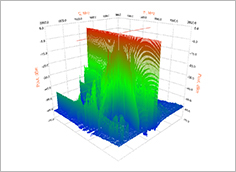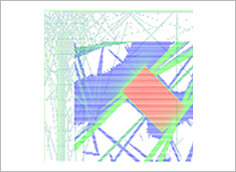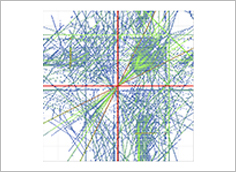ADFTT / ADFTS – AUTOMATED DOUBLE-FREQUENCY TEST TECHNIQUE AND SYSTEM
|
|
|
|
PURPOSE
Automated Double-Frequency Test Technique (ADFTT) and System (ADFTS) are designed to detect, identify (recognize) and measure characteristics of all possible channels and effects of a radio receiver disfunction by the interference through the antenna input, measuring non-linearity parameters of the transfer characteristics of radio components - radio frequency amplifiers, mixers, etc.
ADFTT is an informative highly-productive and effective technology for electromagnetic compatibility testing and measurements of radio receiving devices and radio components.
APPLICATION AREA
- Automated detection, recognition, and measurement of parameters and characteristics of the radio receiver desired response (located at the receiver tuning frequency) and all spurious responses (image responses, spurious responses created by harmonics of the local oscillators’ signals, responses at the intermediate frequencies, etc.), through which the interference can influence the receiver operation;
- Automated detection, identification and measurement of radio receivers susceptibility to nonlinear effects : blocking (desensitization), cross-modulation, intermodulation of all types and orders, reciprocal mixing, etc.;
- Measurement of all standardized RF characteristics of sensitivity, selectivity, and susceptibility of radio receivers and RF components (RF amplifiers, mixers, voltage-controlled oscillators, etc.);
- Electromagnetic compatibility (EMC) analysis and prediction in severe electromagnetic environment with the use of
- results of the radio receiver’s double-frequency testing using ADFTS,
- original technique of discrete nonlinear EMC analysis using DNA EMC,
- original technique of Virtual Testing Area (VTA EMC) which uses geoinformation systems, digital area maps and ADFTS equipment
TECHNICAL CONCEPT
- Impact on the antenna input of the radio receiver under test by the sum of two test signals swept in frequency with defined levels, significantly different frequency sweep rates and wide frequency sweep bands;
- Use of the original technology for visualizing test results on the ADFTS PC display in the form of a 3D image of the double-frequency characteristic (DFC) of the test objects and a number of 2D sections of DFC at various levels of test signals - double-frequency diagrams (DFD).
ADVANTAGES
- It is the most informative, expedient, and efficient technology of radio receiver and radio components EMC testing and measurements;
- It use the original representation of test results in a form of the 3D double-frequency characteristic (DFC) and a number of 2D/2D+ double-frequency diagrams (DFD) of the receiver under test;
- It can be implemented with the use of the standardized equipment set of modern systems for traditional measurements of nonlinear effects (intermodulation, blocking, and cross-modulation) in radio receivers;
- It is used successfully by our customers for designing HF, VHF, UHF, SHF, and EHF radio receivers, systems, and components applied in radio systems of different services (radiolocation, fixed and mobile communications, radionavigation, etc.), civil and military aircrafts, satellites, ships, radars, etc.;
- It is easy integrated with other technique for EMC design on system-level (DNA EMC, VTA EMC, etc.)
DELIVERY OPTIONS
- Development and delivery of the ADFTS on the “turn-key” basis in accordance with the arranged technical specifications
- Adjustment of the Customer’s measuring equipment and delivery of the additional hardware (if necessary) and specialized software
- Supply of the extended hardware and software complex for EMC analysis, monitoring, and prediction which includes:
- ADFTS,
- “EMC-Analyzer” – a specialized expert system for EMC analysis and prediction in local co-site systems,
- “Virtual Testing Area” – a specialized software tool for EMC analysis and simulation of space-distributed radio systems with the use of a geoinformation system and digital area maps.
DEVELOPER
R&D Lab 1.7 "Electromagnetic compatibility of radio equipment"
CONTACTS
6, P. Brovki str., 220013, Minsk, Republic of Belarus
☏ +375 17 293 84 38
🖷 +375 17 293 89 94
🖂 emc@bsuir.by
🌐 emc.bsuir.by
OTHER INNOVATIONS IN THIS AREA


